Health
Speed Keto® | Is it REALLY the Best Way to Do Keto?

Dr. Harlan Kilstein, the founder of Completely Keto and the author who published the Speed Keto® diet program, believes that Speed Keto is the best way to do Keto. Is it true?
Speed Keto®, part of the Completely Keto line of products and services, is a comprehensive diet plan that is marketed at those who are looking for an easier way of doing Keto.
According to Dr. Harlan, Speed Keto® was an ‘amalgamation of everything he’s learned about Keto.’ This was after he was diagnosed with a metabolic condition that introduced him to the diet, and later, as a result of it, established the popular Keto Recipes for Beginners Facebook group (which now has over 1.2 million devoted followers that excitedly share their experiences with Keto at all times of the day).
But, does it even work? And, what about Speed Keto® is actually better than other Keto diet plans available in the market?
Speed Keto® | Does it Work?
According to Dr. Kilstein, there are three big issues with regular Keto that Speed Keto® addresses. However, it is still Keto. Speed Keto® is still totally reliant on the metabolic process called ketosis, which is a scientifically proven fat-burning phenomenon.
In that sense, there is no denying that Speed Keto® does work! It just enhances your Keto experience so that you won’t have to be so stressed about how you’re progressing.
Speed Keto® | HOW Does it Work?
Which brings us to our next big question. How does Speed Keto® work?
According to the Speed Keto® website, the diet plan is unique in that it doesn’t matter if you’re a beginner or if you’ve tried and failed to do Keto in the past. The point of the diet program is to guide you throughout your keto journey so that you can find success easily.
This is done by providing a stress-free keto experience with a ready-made keto meal plan, dozens of 100% keto-friendly recipes, and a quick start guide that guides you through a keto journey that doesn’t involve having to count calories or track macros obsessively.
To put it simply, it’s a complete keto resource that you take with you everywhere so that you won’t have to worry about searching for accurate information on Keto online. Which, according to Dr. Harlan Kilstein, is one of the hardest things to when starting Keto.
What Are Others Saying About the Speed Keto® Plan?
Of course, it’s hard to really say whether a diet plan will work for you if you haven’t tried it yourself. However, Speed Keto has fixed this issue by providing an online community through a Facebook group called Keto Recipes for Beginners — which has gotten so large that it now has over 1.2 million followers.
Here are a couple of Speed Keto testimonials, taken directly from that page:
“I started my weight loss journey at 288.2 lbs. Also at this weight, I was on 2 medications for high blood pressure, prediabetic, inflammation running amok, anxiety issues, depression and I had very very low self-esteem. After losing almost 80 lbs. I don’t have any of these issues anymore. No more medication. I smile and take pictures often now. Sometimes I can hardly believe the difference. Thank you, Speed Keto!” Bayanah Kabad
“Every day is a challenge… Thanks to Speed Keto I am down 30lbs… I not only lost weight but have gained my life back. Being healthy is so important and I feel it. Speed keto was a game-changer for me…” Bobbi Partridge
Overall, it seems that the reception for the Speed Keto® diet plan is largely positive! Scrolling through the Facebook page, there didn’t seem to be any pointedly negative comments either. It’s actually rather inspirational! Which, unsurprisingly, seems to have spurred many others to try the diet out for themselves as well!
The Bottom Line: Is Speed Keto® Better?
Judging from the positive reactions people have had about Speed Keto, it does work. And, for both beginners and keto-veterans (who may or may not have had great success with regular keto the first time), it is definitely a viable option!
The question of whether it is better really depends on what kind of person you are. If you want to keep things short and simple, then the Speed Keto plan is definitely a better choice for you! As a diet program, it should teach you a way of doing keto that takes away all of the complex things (calorie counting, macros tracking, etc.) that can make regular keto difficult – so that you can get straight to getting those results!
Health
Choosing the Right Pilates Reformer: A Practical Buyer’s Guide

Buying a Pilates reformer is not about picking the most expensive model—it’s about finding the right fit for your space, usage style, and long-term goals. Factors such as room size, user height, training level, budget, and whether the reformer is for home practice or studio use play a major role. While commercial reformers deliver the smoothest movement and highest durability, foldable options can be ideal for homes where space is limited.
Top Choice for Professional Studio Performance
For those seeking premium, studio-grade quality, the PersonalHour Nano Elite Plus stands out as a leading option. Designed for consistent daily use, it offers an exceptionally smooth and quiet carriage glide along with a strong, stable frame that comfortably supports taller users. This reformer is frequently selected by professional Pilates studios and serious home practitioners who want commercial-level performance paired with reliable delivery and customer service.
Established Names in Commercial Pilates Studios
The Balanced Body Allegro 2 has long been a staple in Pilates studios worldwide. Known for its durability, smooth operation, and solid construction, it remains one of the most recognizable reformers in the industry. Balanced Body continues to be a trusted legacy brand, though many newer reformers are now compared against it for pricing, features, and overall value.
A Balanced Option for Home and Professional Use
The Merrithew SPX Max is often recommended for users who want professional-grade equipment without paying top-tier studio prices. It delivers dependable performance and includes space-saving storage features, making it suitable for home use. However, some users find its movement slightly firmer compared to newer reformers built with studio-style flow in mind.
Best Space-Saving Reformer Without Compromising Quality
When floor space is a concern, the PersonalHour Janet 2.0 is one of the strongest folding reformers available. Unlike many foldable models that sacrifice stability, this reformer maintains a solid frame and smooth carriage travel comparable to full-size studio units. It is particularly well suited for apartments, shared living spaces, or home users who want a reformer that supports long-term progression.
Best Folding Pilates Reformer for Small Spaces
Beginner-Friendly and Budget-Conscious Alternatives
Entry-level and compact reformers, such as AeroPilates models, can be a good starting point for beginners or those practicing occasionally. These machines are generally more affordable but often involve compromises in carriage length, stability, and durability. As a result, they may not be ideal for advanced exercises or long-term use.
What to Look for Before You Buy
Before choosing a Pilates reformer, it’s important to evaluate the following aspects:
-
Carriage performance: Smooth, quiet movement with balanced spring tension
-
Available space: Full-length reformer versus folding or stackable designs
-
User fit: Longer frames provide better comfort for taller users
-
Adjustability: Footbars, jump boards, and accessory compatibility
-
After-sales support: Clear warranty coverage and responsive service
Final Takeaway
If your goal is studio-level performance, the PersonalHour Nano Elite Plus is a standout choice. For homes with limited space, the PersonalHour Janet 2.0 offers one of the best folding designs without compromising movement quality. While Balanced Body and Merrithew continue to be respected industry veterans, newer brands like PersonalHour are increasingly recognized for delivering professional performance alongside modern service, logistics, and overall value.
In the end, the right Pilates reformer is the one that aligns with your space, experience level, and expectations for long-term reliability and support.
-

 Tech5 years ago
Tech5 years agoEffuel Reviews (2021) – Effuel ECO OBD2 Saves Fuel, and Reduce Gas Cost? Effuel Customer Reviews
-

 Tech6 years ago
Tech6 years agoBosch Power Tools India Launches ‘Cordless Matlab Bosch’ Campaign to Demonstrate the Power of Cordless
-

 Lifestyle6 years ago
Lifestyle6 years agoCatholic Cases App brings Church’s Moral Teachings to Androids and iPhones
-

 Lifestyle5 years ago
Lifestyle5 years agoEast Side Hype x Billionaire Boys Club. Hottest New Streetwear Releases in Utah.
-

 Tech7 years ago
Tech7 years agoCloud Buyers & Investors to Profit in the Future
-

 Lifestyle5 years ago
Lifestyle5 years agoThe Midas of Cosmetic Dermatology: Dr. Simon Ourian
-

 Health7 years ago
Health7 years agoCBDistillery Review: Is it a scam?
-

 Entertainment6 years ago
Entertainment6 years agoAvengers Endgame now Available on 123Movies for Download & Streaming for Free
